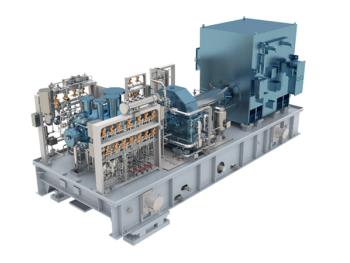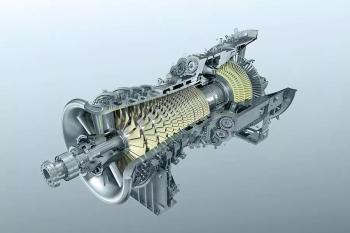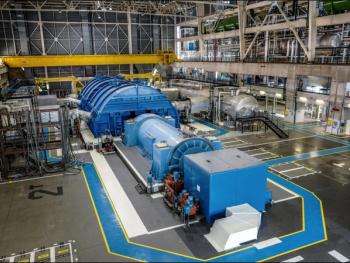
- January/February 2022
CHP upgrades
It's s far from easy to get a natural gas power plant built these days. According to Industrial Info Resources (IIR) data, only about 11% of new generation scheduled for the next five year will be natural gas (the rest will be wind and solar). Developers and asset owners who have delayed or cancelled gas-fired, new-build generation typically cite “market forces” as the reason for their decision. That has led to the cancellation or delay of approximately 48 new-build gas-fired power plants in 25 states that were scheduled to begin construction in 2021 (see Turbomachinery Handbook 2022 cover story, U.S. Power Industry Outlook 2022).
With utilities and independent power producers struggling to bring new combined cycle power plants online, however, there is one area where natural gas-based generation is enjoying real success – Combined Heat & Power (CHP).
According to Entropy Research, more than 80 GW of CHP has been installed in the U.S. at more than 4,600 industrial and commercial facilities. In total, that’s more than 7% of the nation’s generation capacity and 12% of total generation. The vast majority of these installations operate on natural gas.
Part of the reason for CHP success is that it offers a wealth of environmental and economic benefits. As well as offering greater power reliability than the electric grid can usually offer, those deploying CHP cite significant reductions in the cost of energy. Further, they gain process steam, facility heating, and in some cases, an extra revenue stream by feeding excess power into the local grid. And when natural disaster strikes, CHP systems often continue to run in facilities while the grid around them is down.
Eliminating Coal Boilers
Tate & Lyle, a provider of food and beverage ingredients and solutions, recently upgraded a facility in Lafayette, Indiana from coal boilers to CHP.
“Natural gas-fired cogeneration brings cleaner energy online and helps us move away from the use of coal boilers,” said Nick Waibel, Global Energy Lead at Tate & Lyle. “We have set a goal of eliminating coal from all our sites by 2025. Our Decatur, IL facility, is also in the midst of replacing coal boilers with natural gas.
The Lafayette South plant is one of several the company uses to process 2% of the U.S. annual corn crop. The company takes shelled corn (maize), separates the kernels into their core components (starch, oil, protein and fiber), and processes them to create a range of products such as specialty sweeteners and bulk ingredients which are distributed globally. The complexity of corn processing requires an array of boilers, tanks, pumps, distillation columns, milling equipment, separation screens, and evaporators.
“With an eye to the future, our Siemens Energy gas turbines will be able to eventually operate on hydrogen,” said Waibel.
Why CHP?
“Natural gas CHP is an outstanding technology with synergistic benefits for manufacturing plants,” said Waibel. “The thermal demands of the manufacturing process (steam, hot air) drive the efficiency on the system much higher than if we were to provide the electricity and thermal energy to the plant separately. The overall energy efficiency increases from around 50-60% to over 80%, resulting in a big drop in overall emissions and major cost savings. In addition, cogeneration improves plant reliability by providing a local source of power.”
The basic CHP configuration at the Lafayette South food ingredient processing plant is as follows: two Siemens Energy SGT-700 gas turbines and two Heat Recovery Steam Generators (HRSGs) provided by Rentech Boiler Systems in a combined cycle arrangement.
The Siemens Energy units are designed for high output/efficiency and lower emissions with a wide fuel range capability. Due to high exhaust heat, they are well suited to CHP. These units include a third-generation dual-fuel Dry Low Emissions (DLE) combustion system which keeps NOx emission levels low.
“The gas turbine solution from Siemens Energy matches up nicely with our plant design and provides what we need from an energy and environmental impact,” said Waibel.
He explained that with gas turbine performance having large seasonal variation in Indiana, the company chose units that would be able to provide enough power for the plant 365 days a year.
“The seasonality of gas turbines gives a fairly tight window of operation where the turbine can cover 100% of the power demand on a hot summer’s day but have enough turndown on a cold winter’s day to meet emissions requirements,” said Waibel. “The twin SGT-700 design fitted right into that window.”
A big part of the deal was concern about the turbines being future proof. With so much talk about hydrogen and the elimination of fossil fuels, Tate & Lyle wanted to know that their new machines were designed to run on natural gas, hydrogen, or a mixture of both. Although for the foreseeable future, they will run on natural gas.
“With an eye to the future, our Siemens Energy gas turbines will be able to eventually operate on hydrogen,” said Waibel. “In these dynamic times, we had to ensure our investment will serve us in both the near term and the long term. It’s good to know our turbines can make the transition to hydrogen when that supply comes online in the future.”
"The custom-built Rentech HRSGs with duct firing are robust pieces of equipment that are able to provide the plant steam requirements in a variety of process conditions," said Waibel.
Steam Demands
Steam from the CHP plant plays a vital role in corn milling processes as well as in the heating of the facility.
“The thermal demands of the manufacturing process allow manufacturers to extract even more energy out of the exhaust stream than what can be utilized in a combined cycle electricity plant,” said Waibel. “In addition, the turbine exhaust gas can be duct fired to produce more steam at a greater efficiency (essentially 100%) than standard natural gas boilers provide.”
He’s talking about supplemental duct firing, a feature included with the Rentech HRSGs. Waste heat is captured from the turbine exhaust and transformed into steam by the HRSGs. It is then fed into the plant for use in various corn-related processes, as well as to steam turbines as part of combined cycle operations. As supplemental duct burners are included, Tate & Lyle can run them regularly to boost steam production when required.
“Similar to our relationship with Siemens Energy, Tate & Lyle has enjoyed a successful history with Rentech heat recovery boilers,” said Waibel. “Building relationships with competent and high-quality suppliers with proven track records helps to build synergies between our production plants. The custom-built Rentech HRSGs with duct firing are robust pieces of equipment that are able to provide the plant steam requirements in a variety of process conditions.”
Although the plant hasn’t been running long, early results are positive: Waibel notes stronger grid resiliency, greater process efficiency, carbon emissions slashed by more than 30%, and a drop in greenhouse gas (GHG) emissions by around 40%. By replacing aging coal boilers, generating electricity on-site, and recovering heat overall energy efficiency has been boosted while substantially reducing energy costs and cutting water usage by 5%. The plant manager also reports greater process efficiency and power resiliency.
“We take our responsibility to the environment seriously and are committed to doing more to care for the planet, including lowering our greenhouse gas emissions by using cleaner energy,” said Travis Montoya, Lafayette South Plant Manager for Tate & Lyle.
This upgrade project, however, goes beyond the needs of one facility. Stepping back to view the big picture, the company has set targets for 2030 to deliver: a 30% reduction in CO2 emissions; all of its waste to be beneficially used; a 15% drop in water use, and the elimination of coal from its operations by 2025. Getting rid of the aging coal boilers is just one step towards these goals, although it plays a big part in divesting itself of coal usage.
“The Lafayette South Plant project not only helps meet our sustainability goals in reducing greenhouse gas emissions and water use – it’s also a project that saves us money as a company, so it was really a win-win for us,” says Waibel. “Eliminating coal and going into a clean-burning fuel is the right next step for our plant.”
Not the First CHP Rodeo
This isn’t the first CHP installation for Tate & Lyle. The company has several CHP plants running throughout its operations. But the Lafayette South project was inspired by a similar one at another of the company’s corn milling facilities in Loudon, Tennessee.
Back in 2017, the company installed a similar CHP system at that site: two Siemens Energy SGT-700 gas turbines and two Retech HRSGs with supplemental duct firing to replace aging coal boilers. Just like Lafayette, the results at Loudon were impressive: a year-over-year reduction of around 35% in GHGs at the site. The addition of that one CHP plant slashed companywide CO2 emissions by around 10%, as well as leading to improved energy and operational efficiency. The plant manager estimated a reduction in emissions of more than 2,000 tons per year, while satisfying all facility steam needs, and enabling Tate & Lyle to switch from grid power to generating its own electricity. And with the Rentech HRSGs being much more efficient than the old coal boilers, fuel costs were considerably lowered.
The drivers behind the 2017 upgrade, then, were both environmental and economic. As well as the steadily rising price of coal, stricter emissions requirements would have necessitated the addition of expensive pollution control equipment to keep the coal boilers compliant.
“Changing regulations and policies have huge repercussions,” said Waibel. “The environmental targets we have set are some of the most ambitious in our industry.”
Instead of investing in flue gas desulfurization (FGD) and Selective Catalytic Reduction (SCR) technology to stay within Boiler MACT limits, the company decided to spend a little more to revamp and expand its steam and electricity production capabilities – and establish an environmentally responsible pathway for the future.
Energy Stars
The U.S. Environmental Protection Agency’s (EPA’s) Energy Star certification was recently awarded to the corn wet mills in Loudon, Tennessee and Lafayette South, Indiana. Having met strict energy efficiency performance levels, they are the only corn refining plants to earn this accolade. Energy Star was introduced by EPA in 1992 as a voluntary, market-based partnership to reduce GHGs through energy efficiency.
“This reflects the dedication and hard work of our operations team, especially our technicians who are committed to running these mills as efficiently as possible,” said Nick Waibel, Global Energy Lead at Tate & Lyle.
Articles in this issue
over 3 years ago
The Digital Twin Knows it Allover 3 years ago
SELECTION, PURCHASE,AND OPERATION OF TURBOMACHINERYover 3 years ago
SENSORS FOR SPEED MEASUREMENTSalmost 4 years ago
MAN ES emphasizes digital tools and decarbonizationalmost 4 years ago
Sulzer Services expands offeringsalmost 4 years ago
Hydrogen Compressionalmost 4 years ago
Show Report: TPS 2022Newsletter
Power your knowledge with the latest in turbine technology, engineering advances, and energy solutions—subscribe to Turbomachinery International today.




